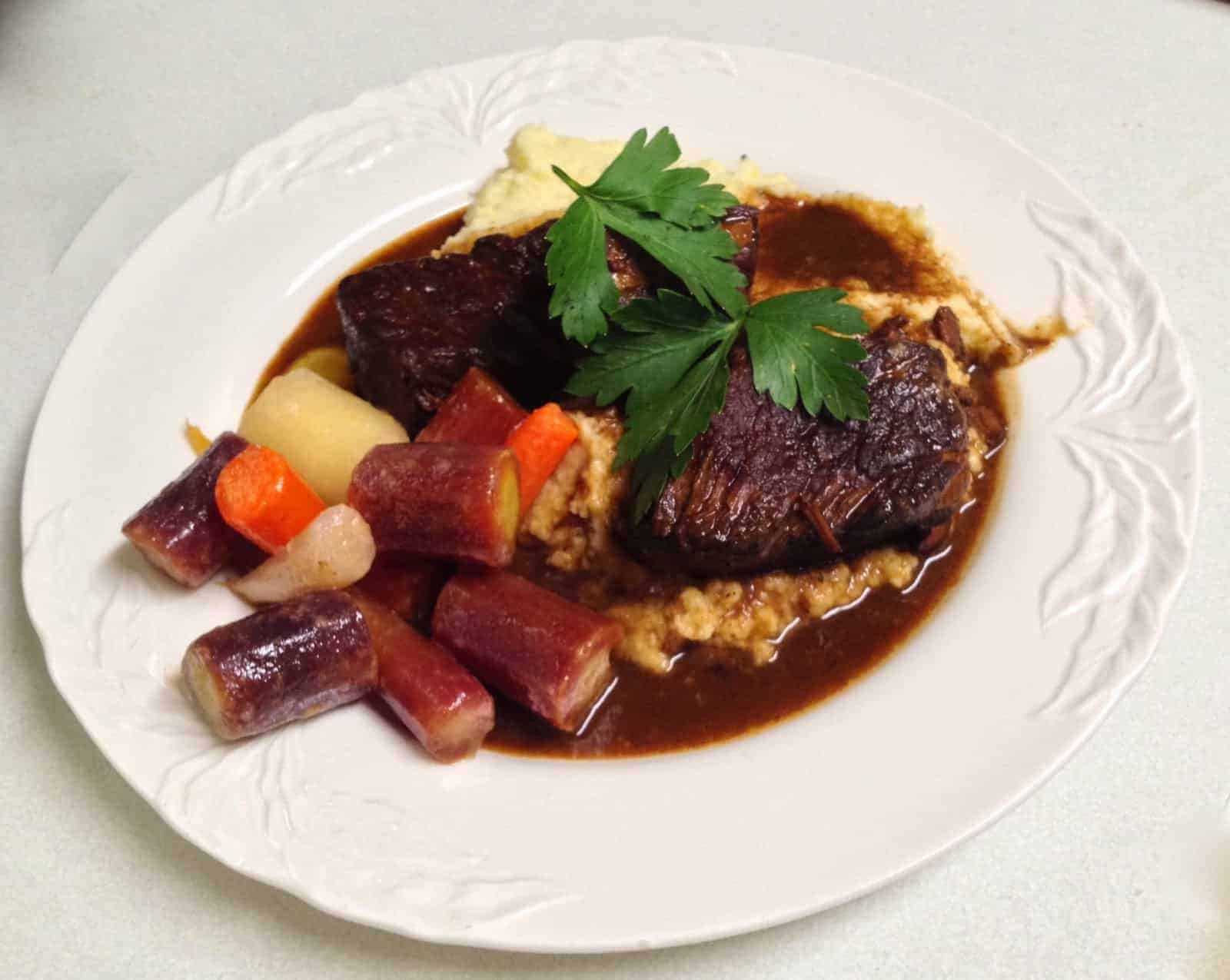 |
| Basilica de Santa Maria del Fiore |
The story behind Peposo, a rich stew that owes its flavor to just two key ingredients –Chianti and Black Pepper—is as fascinating as the finished dish. I read it in Cook’s Illustrated, which, in its usual fashion, went to great lengths to perfect the finished dish. I was much happier with my final version but first, this fascinating piece of food history. In the 15th century, Tuscan tile makers, working on the Basilica di Santa Maria del Fiore, one of Florence’s most cherished landmarks, had to produce 4 million terra cotta tiles to line the dome of the church. Their kilns practically worked non-stop to achieve their goal. For their midday meal, the men would lay cheap cuts of beef and lots of garlic cloves and pepper into clay pots. These pots were then doused with at least a liter of Chianti. Left uncovered, they were placed close to the kilns and slow-cooked until the meat was tender and the wine had turned into a rich, beefy, peppery sauce. The finished dish was then served over slabs of Tuscan bread. I am almost as fond of a good food story as I am of a great recipe so the stew captured my imagination and I went to work making it.
 |
| Andrew Janjigian of Cook’s Illustrated |
Andrew Janjigian of Cook’s Illustrated did a lot of heavy lifting to create the final recipe in the magazine. And true to form, he experimented with many versions of the stew. He went traditional but found the results lacking. He tried modern versions which he pointed out contained everything from onions to carrots, celery to herbs to pancetta. And of course, there were the versions incorporating tomatoes or tomato paste. Janjigian points out that the tomato had not even arrived in Italy at the time the Basilica was being built. Tomatoes were first imported to Spain from South America. The first mention of the tomato in Italy was in 1548 in Tuscany. And, believe it or not, they didn’t really hit their stride there until the 19th century. As to the beef itself, Janjigian reckons that the tile makers likely used shin meat which he praises for its gelatinous quality which would contribute to thickening the cooking liquid. He selected boneless short ribs to which he added salt and gelatin. I made mine with good old fashioned boneless chuck for lack of short ribs. (Costco has great ones, by the way.) And I added the gelatin as well. As mentioned, Janjigian tried to stay true to the original recipe with just four ingredients – beef, a head of separated garlic cloves, cracked peppercorns and a bottle of Chianti. But he was unimpressed with the results. That’s when he really started messing with the recipe.
He seared the ribs –though not all of them—then added anchovy paste to boost the meaty flavor of the ribs, threw in shallots and carrots and yes, he did add some tomato paste. Into the pot went a couple of bay leaves and rosemary sprigs. He played with the timing of adding wine to the dish, pointing out that there’s no need to spend a lot on a bottle. His $5.00 and $12.00 bottles were every bit as well received as a $20.00 one. Finally there’s the all-important pepper. The dish is not called Peposo for nothing and pepper is what distinguishes the dish from say, Beef Bourguignon. So he added pepper at three different points in the cooking process: At the start he added cracked peppercorns. Midway through, when he added more wine, he added ground pepper and finally he sprinkled more cracked pepper on the finished dish. As most of my readers know, there’s very little that drives me crazier than someone altering someone else’s recipe. That being said, I did alter this one. The first time I cooked it, it was sadly lacking in sauce, almost pathetically so. We had lots of beef left over so that when I went to serve it again, I heated the whole batch, then removed the beef from what little gravy was there and added a cup and a half of beef stock and for even more beefy flavor, Bisto, a British gravy maker. The result was exactly as I’d hoped. Rich, wonderful beefy, peppery gravy and plenty of it. So I have altered Janjigian’s original recipe by adding Beef Stock to the final sauce-making in step 4 of the recipe. Served with a celery and potato purée and some colorful organic carrots, the dish was a triumph, if I do say so myself. It’s a perfect cold weather dinner and a great way to spend a winter afternoon in the kitchen. Here is the recipe:














Not traditional but who cares — sounds like you made delicious adjustments. I made it the “authentic” way for my husband’s birthday on Christmas Day — just beef, whole peppercorns, unpeeled garlic cloves and Chianti in a clay cooker in the oven (Bill Buford’s recipe). Good but kinda meh and the whole peppercorns were an adventure to eat. My husband LOVES peposo and eats it at every opportunity. Next time I am going with your version!
Thank you so much for taking the time to write. My dad’s birthday was Christmas Day and my son is Christmas Eve so we have that in common. I did not know Bill Buford had a recipe for Peposo. I must look it up. I adored this one. It was so rich and perfect in winter weather. Again, thanks for commenting!
It’s in “Heat” pp 275-276 in the paperback ed.
Thank you so much Leslie. Did you read “Dirt”? I really loved it. But then, I love Lyon.
Thank you for this recipe. I attended a Milk Street class and made Poposo as a base for a meal and weekly left overs. I liked the meat but the lack of sauce was a bummer. I imagine this is a huge part of the dish that was not there. So, went looking for someone who tinkered with it. This looks so good. Will make again. Any suggestions for what to do with the massive amount of meat (without juice 🙁 leftovers? Made a ragu which was good. Thanks and so happy I found your site!
Thank you so much for taking the time to write, Janna. I really appreciate it. As to your issue about meat without juice, that was not my experience with this recipe. It does occur to me that you could make a second batch of sauce. So pleased to have you here.